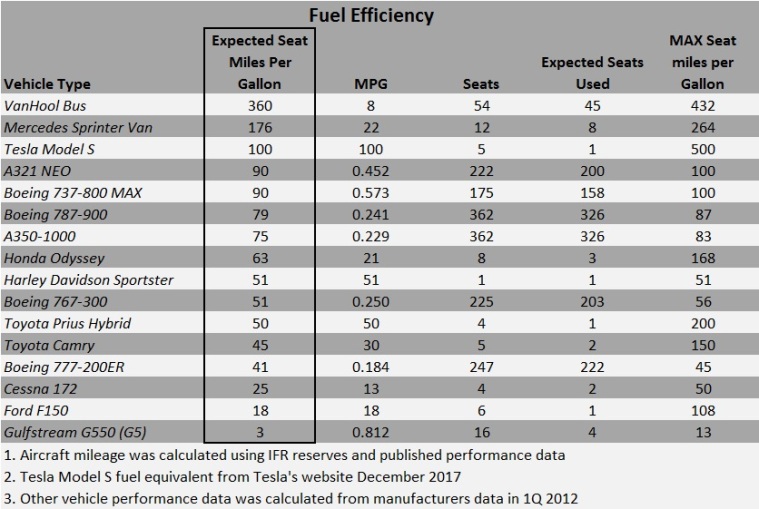We’re surrounded by advertising designed to convince us that some product or activity is green. Lighting, transportation, and hot water combine to form a significant portion of our daily energy consumption. Looking outside our homes, transportation is the largest controllable expense and energy user. Efficiency is tricky and subject to opinions and interpretation so I won’t create an absolute efficiency measurement here. Given Delta Airlines’ recent announcement that they will purchase an oil refinery to better manage their fuel costs let’s compare transportation on a relative basis and use empirical data to show us how different forms of getting around compare against one another?
I define efficiency as an amount of fuel required to move one person one mile (a passenger seat mile). On that basis we can rank Ford F150 pickup trucks against Global Express 550 corporate jets and a Toyota Prius against a motorcycle. Two additional ways we might look at this question are: 1. What’s the maximum efficiency a particular mode could achieve? 2. What’s the most likely efficiency a given mode will achieve?
Data and calculations have been updated to include a Tesla model S, and four airplanes that entered service since this was originally published in 2012. The new list includes the 737MAX, Airbus A321 NEO (New Engine Option), a Boeing 787-900, and the Airbus A350-900. When people are asked which is more efficient, a Boeing 737 or a Toyota Prius, most make a common error and allow speed to affect their judgment about efficiency. The answer depends on the number of full seats. In fact, a 737 filled with a typical number of passengers is more efficient than a Prius with a single occupant. The Prius excels when you start to pack people into it, but most respondents assume that modern jet aircraft couldn’t compete against a hybrid car. This exercise showcases how efficient certain vehicles are. Our runaway winner is the world’s fleet of large tour busses. Operated at capacity these vehicles can move one person between Los Angeles and San Francisco with one gallon of diesel fuel, while a 737 will consume five gallons, and a loaded Prius needs more than two gallons per seat.
The other end of this spectrum is interesting too. How does traveling in First Class by commercial carrier compare to the fuel ‘cost’ required for an individual to travel onboard a private jet? Before we answer this we need to calculate the fuel burn for a first class seat. Boeing reports the 777-200 aircraft could hold 440 seats in a coach class configuration, so we know this plane can achieve 81 miles per gallon for each passenger. Assume that Business Class seats use twice as much fuel as a seat in coach, and First Class seats consume four times more fuel than the average seat in Coach, then for the Boeing 777 we would expect to achieve 20 miles per gallon for each First Class passenger. Compare that to the 13 miles per gallon each seat could generate in a Gulfstream Global Express 550 if every seat was full! Even filling half the seats in the plane would require a fuel burn more than three times higher than consumed by a First class seat on a Boeing 777-200ER and that ignores the frequent ‘repositioning’ flights private jet travel requires.
This table normalizes fuel efficiency based on passenger seat miles. In this example, a Prius with four people would generate four passenger seat miles for every mile driven, while a Boeing 737-800 could generate up to 175 passenger seat miles for each mile flown.
This exercise also points out a paradox in aircraft design – a single aisle Boeing 737-800 is nearly twice as efficient as the larger, double-aisle Boeing 777-200ER. The design requirements for long-haul international flying require more lavatories, large galleys, more storage space, life rafts and a host of other overhead not needed for shorter hops. This paradox creates an opportunity for shorter stage long-haul flying as fuel costs continue to rise. I’ve already shown that absolute fuel burn does not correlate to efficiency the way seating capacity does. Commercial aircraft can move many people very rapidly, and they do it at least as efficiently as cars, and advanced aircraft designs like the 787 Dreamliner, and A350-900 are closing the gap with their single-aisle peers. Motorcycles and minivans are great for moving one or a few people, but it’s very clear that technology scaled for personal transportation doesn’t beat mass transit today. Buses and mini-buses continue to shine in a world where liquid fuels are scarce and expensive and it will be interesting to watch how efficiency demands will shape international and domestic travel in the coming decades.
If you’re interested about commercial aircraft fuel economy you should check out these posts:

This article is moving to paullaherty.com
Paul, your article from 4 years ago has some major omissions in comparing a Prius with a commercial jet:
1. Emissions from jets have roughly three times the global climate change impact of emissions at ground level
2. Because jets are much faster than surface vehicles, people tend to travel much further when they travel by jet, which results in much higher fuel consumption.